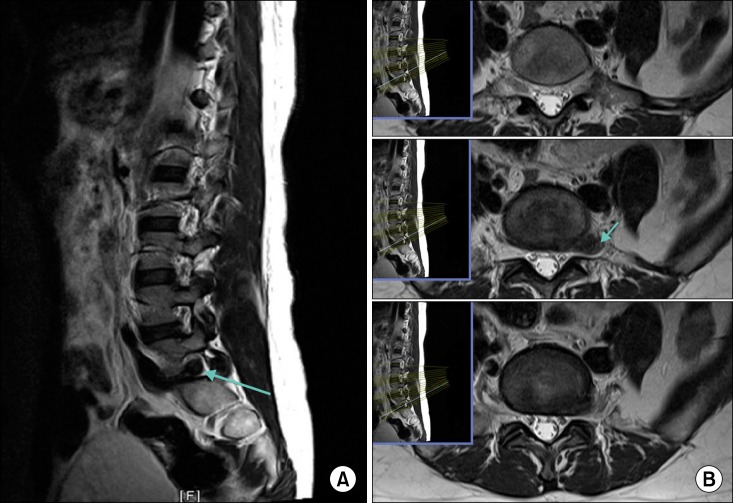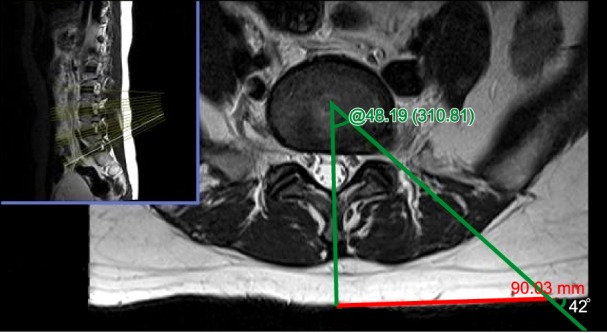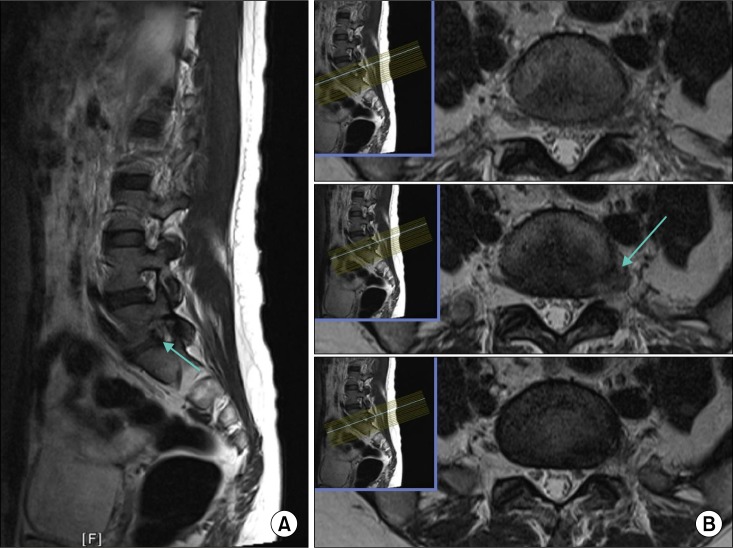Korean J Pain.
2016 Jan;29(1):57-61. 10.3344/kjp.2016.29.1.57.
A Modified Approach of Percutaneous Endoscopic Lumbar Discectomy (PELD) for Far Lateral Disc Herniation at L5-S1 with Foot Drop
- Affiliations
-
- 1Department of Anesthesiology and Pain Medicine, School of Medicine, Ewha Womans University, Seoul, Korea. ingoo97@lycos.co.kr
- KMID: 2151662
- DOI: http://doi.org/10.3344/kjp.2016.29.1.57
Abstract
- Foraminal or extraforaminal Far Lateral Disc Herniations (FLDH) extending into or beyond the foraminal zone have been recognized as between 7-12% of all lumbosacral disc herniations. Conventional posterior laminectomy may not provide good access to a herniation that lies far lateral to the lateral margin of the pedicle. Use of the endoscopic technique through a percutaneous approach to treat such FLDH patients can decrease the surgical morbidity while achieving better outcomes. We made an effort to utilize the advantages of percutaneous endoscopic lumbar discectomy (PELD) and to determine the appropriate approach for FLDH at the level between the 5th Lumbar and first Sacral vertebrae(L5-S1). The authors present a case of an endoscopically resected lumbar extruded disc of the left extraforaminal zone with superior foraminal migration at the level of L5-S1, which had led to foot drop, while placing the endoscope in the anterior epidural space without facetectomy.
Keyword
MeSH Terms
Figure
Reference
-
1. Epstein NE. Evaluation of varied surgical approaches used in the management of 170 far-lateral lumbar disc herniations: indications and results. J Neurosurg. 1995; 83:648–656. PMID: 7674015.
Article2. O'Hara LJ, Marshall RW. Far lateral lumbar disc herniation. The key to the intertransverse approach. J Bone Joint Surg Br. 1997; 79:943–947. PMID: 9393908.3. Choi G, Lee SH, Bhanot A, Raiturker PP, Chae YS. Percutaneous endoscopic discectomy for extraforaminal lumbar disc herniations: extraforaminal targeted fragmentectomy technique using working channel endoscope. Spine (Phila Pa 1976). 2007; 32:E93–E99. PMID: 17224806.4. Ohmori K, Kanamori M, Kawaguchi Y, Ishihara H, Kimura T. Clinical features of extraforaminal lumbar disc herniation based on the radiographic location of the dorsal root ganglion. Spine (Phila Pa 1976). 2001; 26:662–666. PMID: 11246382.
Article5. Park HW, Park KS, Park MS, Kim SM, Chung SY, Lee S. The comparisons of surgical outcomes and clinical characteristics between the far lateral lumbar disc herniations and the paramedian lumbar disc herniations. Korean J Spine. 2013; 10:155–159. PMID: 24757478.
Article6. Yoshimoto M, Iwase T, Takebayashi T, Ida K, Yamashita T. Microendoscopic discectomy for far lateral lumbar disk herniation: less surgical invasiveness and minimum 2-year follow-up results. J Spinal Disord Tech. 2014; 27:E1–E7. PMID: 23429311.7. Garrido E, Connaughton PN. Unilateral facetectomy approach for lateral lumbar disc herniation. J Neurosurg. 1991; 74:754–756. PMID: 2013776.
Article8. Kim JE, Kim KH. Piriformis syndrome after percutaneous endoscopic lumbar discectomy via the posterolateral approach. Eur Spine J. 2011; 20:1663–1668. PMID: 21416279.
Article9. Kim KH. Use of lidocaine patch for percutaneous endoscopic lumbar discectomy. Korean J Pain. 2011; 24:74–80. PMID: 21716614.
Article10. Reulen HJ, Müller A, Ebeling U. Microsurgical anatomy of the lateral approach to extraforaminal lumbar disc herniations. Neurosurgery. 1996; 39:345–350. PMID: 8832672.
Article11. Choi KC, Kim JS, Ryu KS, Kang BU, Ahn Y, Lee SH. Percutaneous endoscopic lumbar discectomy for L5-S1 disc herniation: transforaminal versus interlaminar approach. Pain Physician. 2013; 16:547–556. PMID: 24284840.12. Yeung AT, Tsou PM. Posterolateral endoscopic excision for lumbar disc herniation: surgical technique, outcome, and complications in 307 consecutive cases. Spine (Phila Pa 1976). 2002; 27:722–731. PMID: 11923665.
- Full Text Links
- Actions
-
Cited
- CITED
-
- Close
- Share
- Similar articles
-
- Simultaneous L4-5 Transforaminal and L5-S1 Interlaminar Percutaneous Endoscopic Lumbar Discectomy for L4-5 Down Migrated Disc: A Technical Case Report
- Percutaneous Endoscopic Lumbar Discectomy for L5-S1 Foraminal Disc Herniation with Superior Migration using Contralateral Interlaminar Approach: A Technical Case Report
- Percutaneous Endoscopic Interlaminar Discectomy for L5-S1 Disc Herniation: Axillary Approach and Preliminary Results
- Percutaneous Endoscopic Lumbar Discectomy (PELD) Using Interlaminar Approach in Lumbar Disc Herniation: Endoscopic Laminotomy
- Percutaneous Endoscopic Lumbar Discectomy (PELD)





